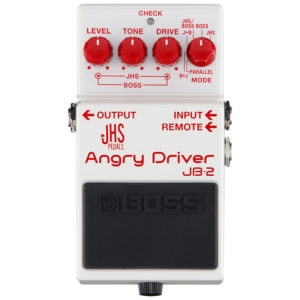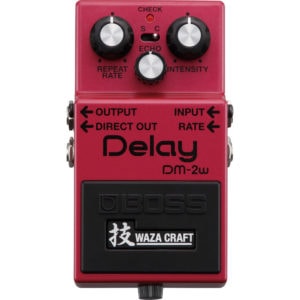
The Beginner’s Guide to Guitar Effects Pedals – 5 Must Haves!
Whether you’ve just got your first electric guitar, or you’ve been playing for a while and want to explore some new sounds. You’ve probably seen those fancy, coloured boxes on the floor next to your favourite guitarists. You’ve probably also wondered what the hell each one of them does! In this day and age, there are literally hundreds of different guitar effects pedals, and they all do different things. So in this article, we’re going to cover 5 of the most popular type of effects pedals, and show you what each one can do to your sound!
What is a Guitar Pedal?
To put it simply, guitar effects pedals are small circuitry boxes that require you to step on them to activate an effect. Which is where the nickname “stompbox” comes from. Depending on the type of effect you have, pedals can drive, distort, modulate, reverberate your guitar tone, and more.
Your guitar and the amp you’re using both contribute to the sound of your guitar. But having effects pedals in your arsenal just takes things to the next level. Giving you, even more, control over the final sound of your guitar.
So do you NEED guitar pedals? No, however, they’re a great way to expand your creativity and create some truly unique sounds.
How do you use a guitar pedal?
To get your guitar pedals working, you’ll want to plug your quarter inch guitar cable into your effects pedal. Then the other end of your cable into your guitar amp. Alternatively, if you’re wanting to use more than one pedal at a time, you can use shorter patch cables to link them all up.
Using pedals through long runs of cables can also weaken the signal. So you’ll want to ensure your chain of cables is kept short, allowing you to have a constant signal flow from your guitar to your amp.
The 5 Must Have Guitar Effects Pedals for Guitarists
Guitar Tuner Pedal
Technically, it’s not an effect at all, and it won’t make you any cool sounds. However, having a guitar tuner pedal is a basic staple in any pedalboard and definitely worth investing in. Your amp might already have a built-in tuner, or you might just be relying on your smartphone. But still, it’s a good idea to get yourself a dedicated tuner pedal.
You should get in the habit of tuning your guitar as best you can before every time you play it. Because the last thing you want is to get used to a slightly out-of-tune guitar that might sound fine to you. But sound like nails on a chalkboard to your audience or band members.
Another reason for getting your hands on a tuner pedal is that it gives you an easy way for muting your signal when you need to. It doesn’t sound like much, but so many performing guitarists use a tuner solely for this reason.
Overdrive Pedal
We’ve covered the tuner, now on to the fun stuff. Overdrive is a popular type of effects pedal that all musicians should at least experiment with. Rock and Metal music is filled with those searing, crunching sounds of amplifiers being driven to their limits. But as you can imagine, it’s especially difficult to achieve at a reasonable volume. So that’s where overdrive pedals come in. Allowing you to emulate the sound of those cranked up amps in the simple form of a compact pedal.
Overall, if you’re wanting to sound like any of your favourite Rock or Heavy Metal bands, then you need an overdrive pedal in your pedalboard.
-
 $49
$49Behringer TO800 Vintage Tube Overdrive Pedal – DJ City
-
 Free Shipping$89
Free Shipping$89Boss SD-1 Super Overdrive Guitar Effect Pedal
-
 Free ShippingOriginal price was: $199.$189Current price is: $189.
Free ShippingOriginal price was: $199.$189Current price is: $189.DigiTech Carcosa Fuzz DOD Distortion Overdrive Pedal
-
 Free Shipping$259
Free Shipping$259Digitech Looking Glass Overdrive Pedal
Shop Overdrive, Distorion & Fuzz Pedals
Distortion & Fuzz Pedals
Next up we’ve got Distortion pedals. Picking up where the overdrive pedal left off; Distortion & Fuzz brings a new world of harder levels of clipping.
Distortion pedals pick up where overdrives leave off, bringing a world of hard-edged, chunky palm mutes and saturated soaring lead sounds. For those who need full-on metal saturation and grind, but don’t have the budget for a high-gain monster amplifier, a distortion pedal is what you need.
-
 Free ShippingOriginal price was: $95.$89Current price is: $89.
Free ShippingOriginal price was: $95.$89Current price is: $89.Boss DS-1 Distortion Guitar Effect Pedal
-
 Free Shipping$179
Free Shipping$179ProCo Rat 2 Distortion Effects Pedal
-
 Free Shipping$329
Free Shipping$329Boss JB-2 Angry Driver Pedal
-
 Free Shipping$299
Free Shipping$299Source Audio Aftershock Bass Distortion Effects Pedal
Shop Overdrive, Distorion & Fuzz Pedals
Delay Pedal
Another must-have for your pedalboard is a delay pedal, although this category does cover a deceptively large spread of pedals. At the core of it, the delay is essentially an echo effect. The first type of delay pedals did just that, using tape loops. As time’s gone on, we’ve started to see a number of other effects created by time-based manipulation of signals including flangers and chorus. And also led to the guitar looper pedal and pitch shifter!
Reverb Pedal
Reverb Pedals are much like a Delay in many ways. Imagine yourself rocking out in front of a massive hall or stadium, you hear a certain “space” after you strum a note. Using a reverb pedal is going to allow you to achieve that same texture without having to hire out a venue or stadium. But use it carefully and in moderation and you can achieve a much richer tone and add another layer of ambiance to your guitar playing.
Pitch Shift Pedals
Finally, Pitch Shifting Pedals such as the Digitech Whammy Ricochet let you bounce your sound up and down pitch in crazy shifts. With a momentary switch, customizable independent rise and fall time ballistics; pitch shift guitar pedals allow you to get that Whammy sound you know and love!
Shop Pitch & Modulation Pedals
What else?
The following pedals aren’t a must, but they’re nice to have. And can certainly add some creative flair to your performance.
Chorus Pedals
Chorus Pedals like the BOSS CH-1 turn your guitars signal into a number of different voices. Modulating pitch and timbre, while delaying those new voices slightly from the main signal. As a result, you have an ensemble of different sounds that act as though you’ve got multiple instruments playing at the same time. Perfect for fattening up your mix with layers of different sounds.
Synthesizer & Vocoder Pedals
Synthesizer Pedals allow you to unlock all the tones that were previously only available to keyboard players. Whether it’s atmospheric pads, driving synth leads, or even the daft punk-esque sounds of a vocoder; synth pedals unlock a new realm for your instruments. Something like the BOSS SY-1 has over 120 different sounds you can experiment with!
Shop Pitch & Modulation Pedals
EQ Pedals
Equalization or EQ Pedals essentially allow you to cut or boost specific frequencies in your guitar signal. Kind of similar to the way your Treble/Mid/Bass controls work on your amp, except you get much more control over specific frequencies.
Compressor Pedals
One of the most popular effects in recorded music, Compression works by essentially making soft parts louder, and loud parts softer. It’s a great tool when used appropriately but again it’s not something you’d want to use for every style of music. However, is quite popular among electric guitarists.

































